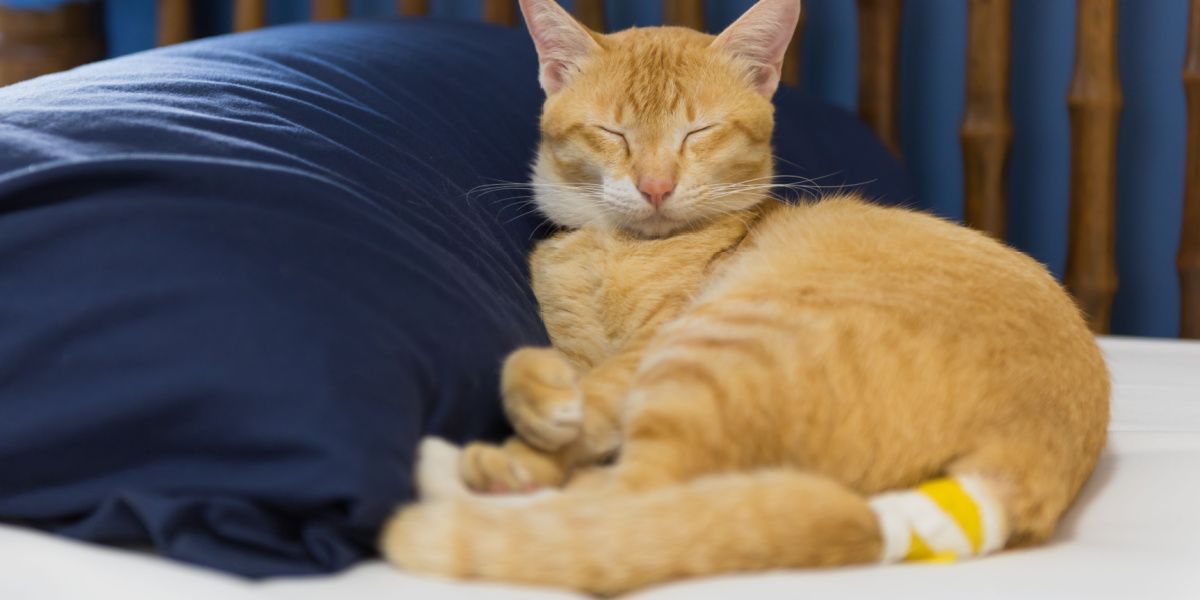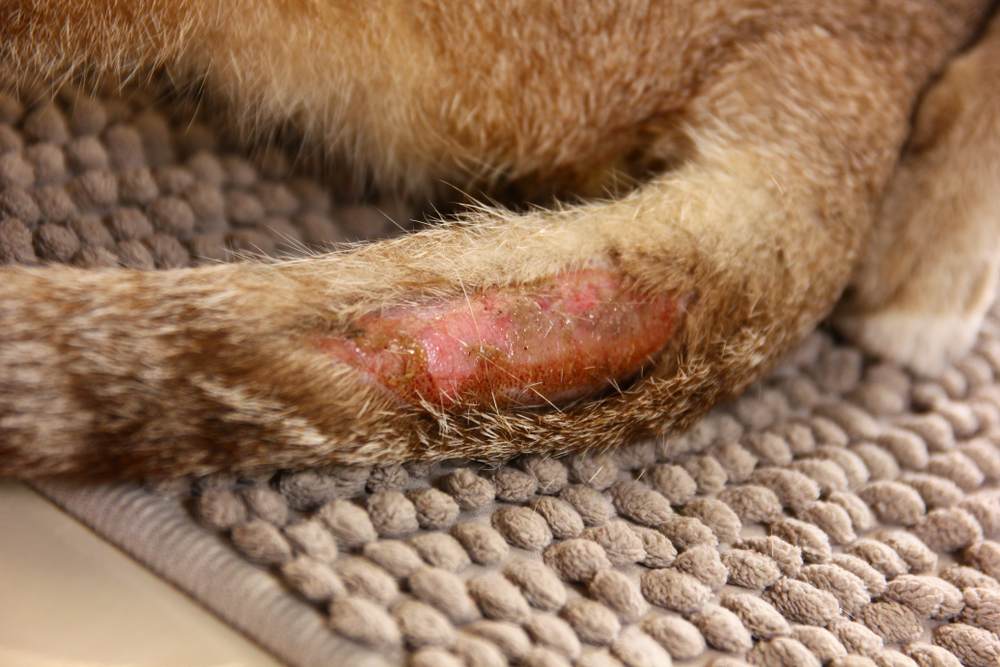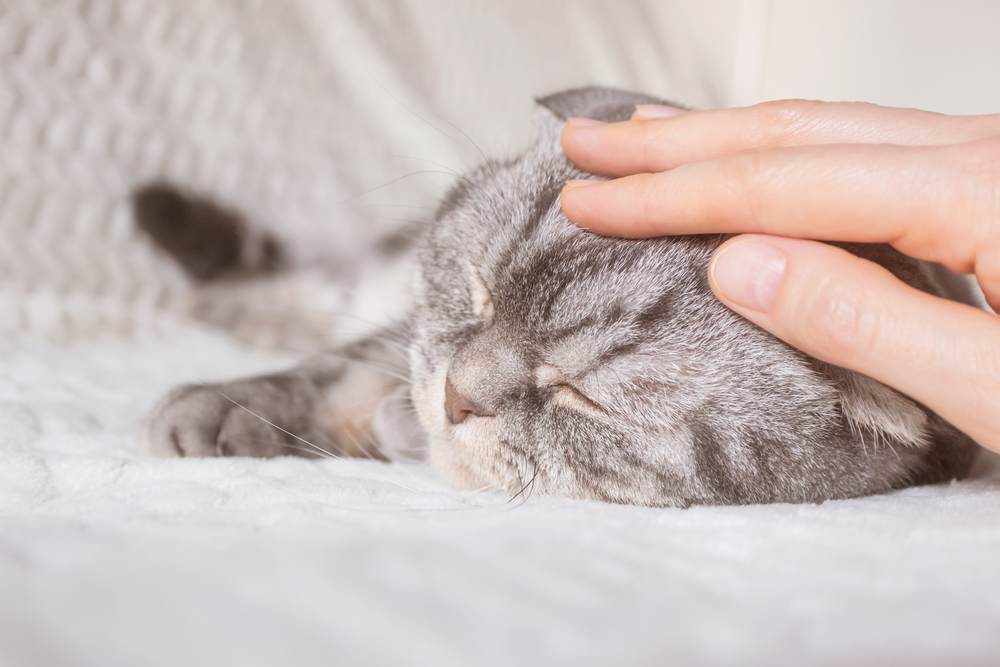
Cats are adventurous and curious pets. Unfortunately, their curiosity can sometimes cause them to get injured. Tail injuries in cats are a common occurrence and one that I see regularly as a vet. Cats, particularly ones with outdoor access, can easily injure extremities such as their tail and limbs.
Cats’ tails are important structures and injury to them can be very serious – especially if the nerves are damaged. In this article, I’ll discuss everything that you need to know about the causes of tail injuries in cats, the symptoms and what you can do to help your cat.
Causes of Tail Injuries in Cats
Many cat owners reading this may have already experienced a tail injury in their cat – it’s a common injury in felines, as their tails can easily get stuck in things, cut or bitten. Tail injuries are more common in cats with outdoor access, as the risk of injury from other cats, dogs, cars and the environment is much higher.
The common causes of tail injuries in cats include:
Abrasions and Cuts
Just like any other part of the cat’s body, their tail can suffer from cuts or lacerations if they come in contact with something sharp. As cat’s tails are quite long and agile, they are more exposed to sharp things on the ground. Cuts or lacerations may be hard to see with cat’s fur, but there will likely be some blood or swelling present.
Cat Fight Injury
Territorial fights are common with cats and unfortunately, bites and scratches on the tail are all too common. Bite wounds on the tail usually occur when a cat is trying to run away from the other cat. They can be extremely painful and sensitive to touch, and your cat will likely react badly when you examine them. Bite marks may be visible and there will likely be some swelling, redness and discharge around the wounds.
Abscess
Bites or wounds on the tail can form an abscess, which is large pocket of pus due to infection. This usually occurs after a bite from another cat but it can occur with bites from dogs, other animals or insects. Abscesses form large swellings that eventually burst and drain and are very painful.
Tail Fracture/Dislocation
Cats love to venture outdoors: climbing walls and exploring their environment. Unfortunately sometimes this may lead to their tail getting stuck in doors/fences or getting hit by a car. This may lead to a tail fracture/broken tail or dislocation of one or more of the bones in the tail. Cats with fracture/dislocation will be very sore around their tail, may not move their tail or their tail may be bent at an angle.
Skin Allergies

Overgrooming and self-trauma can do significant damage to a cat’s skin, including on and around the tail.
Allergies (flea, food and environmental) are very common in our feline friends. Cats can be affected anywhere on their body, even their tail. Allergies may present as scabs or skin lesions on their tail with or without hair loss. They often have a secondary skin infection. Cats may overgroom their tail as they’re so sore and itchy. They may also have skin lesions on other parts of their body.
Feline Hyperesthesia Syndrome
This syndrome occurs when cats have extreme sensitivity to their skin, usually the skin on their lower back and tail. It can cause them to bite their skin and even mutilate their tail. If you notice your cat twitching their skin, vocalising or having self-inflicted injuries they may have this condition.
Tail Pull Injury
One of the more serious tail injuries that I treat is called tail pull injury, also known as a ‘fan-belt’ injury. This happens when the cat’s tail get pulled during a trauma, usually from being hit from a car or getting their tail stuck in a car engine. When the tail gets pulled, it damages some of the nerves affecting the tail and bladder. This can cause problems for cats with regards to toileting, walking and balance. Some of the skin may also be missing from the tail, known as a de-gloving injury.
Symptoms of Tail Injuries in Cats
Now that we know what causes tail injuries in cats, we should know what to look out for. Some tail injuries may be obvious and others may be hard to spot, due to cats’ dense fur and their propensity to hide pain and illness. If your cat has been hurt in any way, it’s always worth gently examining their tail for potential injuries.
Symptoms of tail injuries in cats to look out for include;
- Not moving their tail
- Keeping their tail down
- Sensitive when their tail is touched
- Wounds/cuts on tail
- Hair loss on tail
- Reddened skin
- Inflamed/swollen skin
- Swelling/lump on tail
- Tail bent/not aligned
- Skin missing from their tail
- Bleeding
- Trouble urinating/defecating
Complications of Tail Injuries
The most worrying part of tail injuries is when there is nerve damage. This is often seen with a tail pull injury, usually after a cat has been hit by a car or gotten their tail stuck in something resulting in a pull on the nerves in their tail. Cats with nerve injury often can’t urinate or defecate on their own. These cats often need to have their bladder expressed until the nerve damage heals, or be assisted to toilet.
Many cats regain nerve function and control of their toileting in time, however this doesn’t occur for all cats. Some cats don’t regain nerve function to their bladder and will permanently need their bladder expressed for them – or conversely, they may suffer from urinary incontinence and fecal incontinence. They will also likely need their tail amputated. If this occurs with your cat, it’s important to have a discussion with your vet about your cat’s prognosis and options.
Diagnosis of Tail Injuries in Cats
Tail injuries in cats can be very serious. It’s important to contact your vet straight away if you think your cat’s tail is injured. They can advise you on what to do next. In most cases, they’ll want to see your cat to examine them.
In cases of minor tail injuries, such as cuts and abscesses, a physical examination may be all that is needed to diagnose the problem. However if your vet suspects a more serious injury, they may recommend blood and urine testing, alongside x-rays or other imaging techniques. X-rays are useful to check for fractures or dislocations. If your cat has been hit by a car, your vet may need to image their abdomen and chest to check for other injuries.
Treatments for Tail Injuries in Cats
The treatment for tail injuries in cats varies depending on what the underlying cause is. For minor injuries such as small cuts, abrasions or underlying skin disease your vet may prescribe antibiotics, anti-inflammatories and potentially a pet cone (also called an Elizabethan collar or E-collar). For injuries such as cat bites or abscesses your vet may need to flush and clean the wounds under sedation. They may also prescribe medication such as pain relief and antibiotics.
For serious injuries, such as tail fractures, they may heal on their own with time, rest, and pain medication. However, in some cases the veterinarian may need to amputate part of your cat’s tail if they’re badly fractured or damaged. Your vet will discuss this with you.
Tail pull injuries may require further treatment as they’ve usually been caused by trauma and affect some essential nerves. This may include intravenous fluid therapy, hospitalisation and medication. Some cases of tail pull injury require surgery and a tail amputation and may require cats to have their bladder expressed for a certain period of time until the nerves heal.
Cat Care Tips

Cats with tail injuries may need help with eating, drinking and toileting, and may well appreciate some extra fuss!
Tail injuries in cats can be painful and it’s hard to see our kitties in discomfort. There are some things that you can do at home when caring for your cat to ensure that they’re comfortable.
Avoid Bandages
If your cat has suffered a mild wound/cut on their tail, avoid placing dressings or bandages on it unless your vet has advised to do so. Bandages often aren’t well tolerated on the tail and they can also compromise the blood circulation. Though well meant, it may cause more harm.
Keep Them Indoors if Possible
Cats with tail injuries should be kept indoors while they’re healing, if this is possible. This won’t be possible with cats that are feral but it should be tolerated in cats that are used to being inside and are tame. Keeping them indoors for the short-term will give their tail time to heal without the risk of further injury.
Easier Access to Resources
Cats that are injured, or wearing a collar/cone, may find it more difficult to access food, water and their litter box. You might need to make this easier for them by bringing their food/water to them or raising the level of the bowls. Litter boxes with hoods and doors may need to have these removed (leaving an uncovered box) to make it easier for cats to toilet.
Lots of TLC (If They Want It)
It’s likely that your cat will be out of sorts when they have a tail injury, particularly if they’re wearing a cone of shame. Offer lots of cuddles and TLC, if your cat looks for it. Some cats may prefer to be on their own and that’s ok too!
How To Prevent Tail Injuries in Cats
Accidents happen and in a lot of cases, there isn’t much that we can do to prevent them. However, in the case of cat tail injuries there a few things we can do.
Cats with outdoor access have a much higher chance of tail injuries. Preventative measures against tail injuries may mean keeping your cat indoors at night time when the risk of injury with other cats or cars is very high. Reflective cat collars (although check that they’re safe, with a quick release) will also help vehicle drivers to see your cat as their lights will reflect off your cat’s collar.
To reduce cat fights, ensure that all of your cats are neutered and ask your local veterinary clinic or shelter for help with neutering any feral cats that are around. Avoid feeding stray or feral cats in your garden where your cats are as this will increase tension between cats. Instead, feed them away from your house, in a safe area away from roads.
To prevent flea allergies, keep your cat up to date with flea and ectoparasite prevention with treatment from your veterinary clinic.
Also Read: 11 Signs That You Need to Get Your Cat To the Emergency Room







